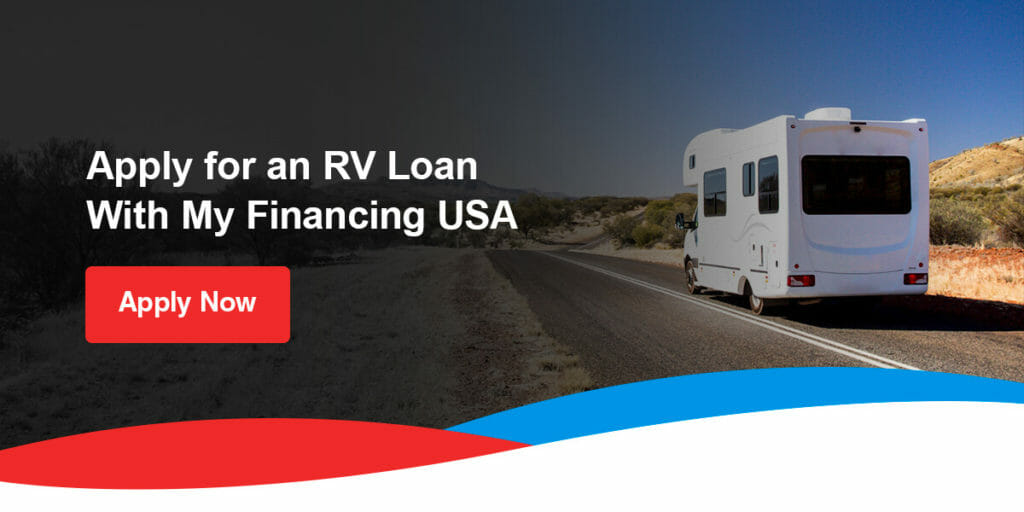When you're out on the open road, part of the fun is entering unfamiliar cities and exploring remote areas. However, your risks of encountering an obstacle or a hazard increase while you're out having new experiences. Additionally, traveling in your RV for extended periods of time means you're more likely to encounter vehicle maintenance issues. These problems will put a damper on any road trip.
Fortunately, you can travel safer by reading our RV safety tips below.
Preparations to Make Before Leaving
Before you start your trip, you should have a mechanic service any vehicle you plan on bringing. Both you and your mechanic should go over a comprehensive RV safety inspection checklist, such as the following:
- Check the oil and change if necessary.
- Check the transmission fluid and coolant levels.
- Inspect the tire tread and rotation for wear, and estimate when to buy new tires.
- Check the tire air pressure.
- Examine the tow bar and the safety cables if you're towing a vehicle.
- Examine the RV's attachments to ensure they retract easily.
- Look for any leaks under your RV.
- Assess all brakes, including the tow brake and parking brake.
- Check the propane tank and exhaust lines for issues.
- Make sure the RV has the proper RV safety labels visible.
- Ensure emergency smoke, propane and carbon monoxide detectors work properly.
- Inspect the roof and all seals and gaskets for signs of potential leaks.
- Inspect all equipment and test for proper operation.
When you're certain your RV is ready for the road, you'll want to weigh and measure it so you know what to expect regarding potential road restrictions. When you have the RV fully loaded, drive to a weigh station to get the most accurate weight. It's also important to know your RV's height. When you buy a new RV, this information is usually on the Manufacturer’s Certificate of Origin (MCO), and you can also find this on the manufacturer’s VIN sticker attached to the RV.
Before you hit the road, make sure you do some research. Check out the routes you're going to take to your destinations so you're aware of any weather events, ground hazards, road restrictions or other possible obstacles. While a GPS is handy, you can't go wrong doing your own navigational work to ensure everything is in order. Most GPS devices and mapping apps do not take height and weight restrictions into account when plotting a route, and tolls are usually higher for RVs than typical autos.
RV Tire Safety Tips to Keep in Mind
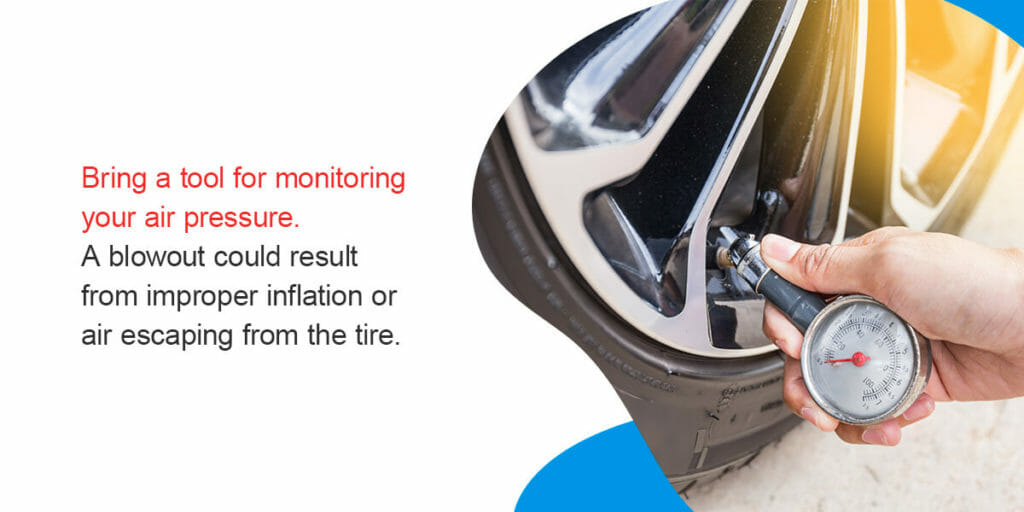
When you make a cross-country trip totaling hundreds of miles, your tires tend to wear down quickly. Below are some safety tips specifically for your tires:
- Protect the tires: Consider getting tire and wheel road hazard protection, like from My Financing USA. These services are affordable and provide peace of mind when you’re away from home.
- Keep tires covered: This includes the spare. When your RV isn't in use, covering the tires helps to prevent ozone and ultraviolet (UV) damage.
- Wash the tires: Regularly wash your tires to prevent cracking and tread loss from abrasive materials.
- Monitor tire air pressure: Bring a tool for monitoring your air pressure. A blowout could result from improper inflation or air escaping from the tire. In cold weather, you might notice your tires need a little more air.
- Be careful when removing air from tires: If you need to remove air, avoid leeching the air when the tires are hot. As the tires cool, they'll shrink, potentially resulting in an under-inflation issue.
- Stop the RV properly: Always block and level the RV once you stop at a camping site.
- Avoid cleaning products with petroleum, alcohol or petrochemicals: These elements could strip away the thin layer of ozone protection and lead to cracking.
- Know when to replace the tires: Replace tires older than five years, even when they seem to be in good condition, or when the tread depth has reached close to 1/16 of an inch — whichever comes first.
- Keep an active insurance policy: RVs can suffer damage even when parked and stored, so maintaining insurance on the RV year-round is crucial to protecting yourself financially from unexpected damages. If you have a loan on the RV, purchasing a GAP policy with your loan — like the ones offered by My Financing USA — will ensure that if you suffer a total loss, you won’t still be stuck paying back the loan.
How to Practice RV Safety While Driving
Because RVs are large, bulky vehicles, making sure to drive safely is key. Here are some RV travel safety tips for when you're driving and parking:
1. Use the S.A.F.E. Cornering Method
RVs are heavy and long, making them challenging to corner. The S.A.F.E. cornering method can help:
- Slow: Make a slow approach to the corner. If you have to brake quickly, it's best to be moving slowly.
- Arc: Make an arc as you turn. Keep in mind that other drivers might be unsure of your intentions if they see your RV moving in the opposite direction of where you intend to drive.
- Finish: Come to a complete finish of your turn before you stop. Ensure the tail of your vehicle successfully clears the pivot point.
- Experience: Gain experience through practice.
2. Drive Slower Than Usual
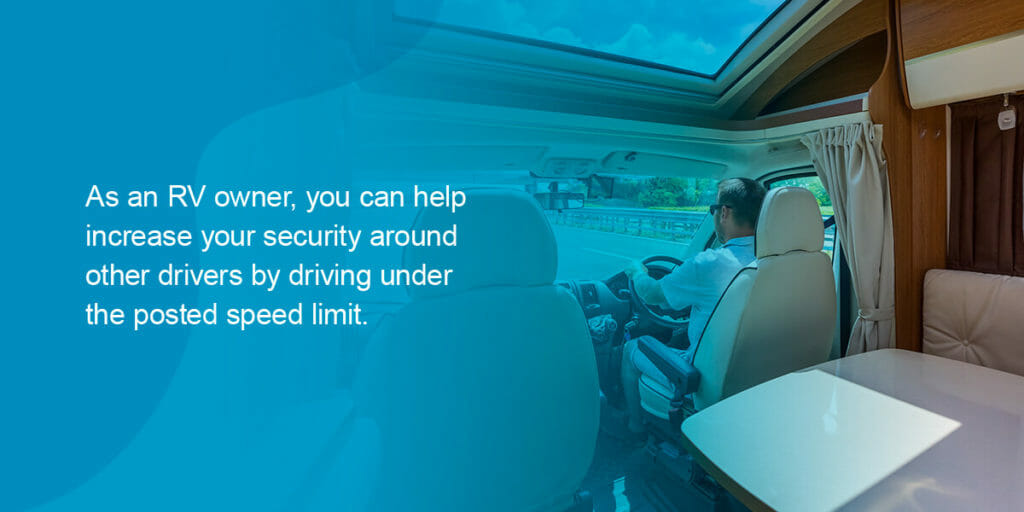
RVs accelerate and decelerate slower than your average passenger car. As an RV owner, you can help increase your security around other drivers by driving under the posted speed limit. Give yourself a movement handicap of 20% to compensate for your vehicle's slower reflexes.
For example, increase your following distance to keep yourself clear of the vehicle in front of you. To merge safely, look for about 20% more clearance than you normally would. Overall, drive slower so that you can decelerate easier.
3. Maneuver More Cautiously
RVs face potential hazards like overhangs or low-hanging branches because of their height. RVs are also more susceptible to hitting ground objects that may be difficult to see from your vantage point behind the wheel. If you must park your RV in a tight space around other vehicles or obstacles, be sure to maneuver safely:
- While backing up, ask a passenger to assist you by standing outside and motioning to guide you out of a confined space.
- Communicate with passengers standing outside of the RV using a set of walkie-talkies. This will allow them to warn you of any approaching vehicles while you're trying to move the RV.
- If you can, pull out of the parking area by driving forward. This helps you avoid having to navigate around your blind spots.
4. Make Sure Other Drivers Can See You
Other drivers can have trouble noticing your RV even though it's a larger vehicle. An accident or driving error can happen around you when a neighboring driver is tired or not paying attention to blind spots.
Use the following tips to help keep your RV in view:
- Use turn signal wisely: Try to use your turn signal 100 feet before you have to make the turn. If you flip on your signal too close to your exit or street, another driver might attempt to pass your decelerating RV and end up causing an accident.
- Slow down properly: If your turn is 100 feet away, but you still have to pass an exit or street before you turn, you can turn on your signal closer to the exit while slowing down. By decreasing your speed, you can give drivers behind you a better idea of when you're turning.
- Change lanes with caution: Make cautious choices when passing other drivers or making lane changes.
- Be careful when getting tailgated: If someone is tailgating you, maintain your speed. If the other driver has access to a parallel lane, slowly and carefully decelerate to encourage them to pass you. Never increase your speed when another driver is tailgating your RV.
Tips for Your Child's Safety While Roadtripping in an RV

If you're traveling with children, here are some points to keep in mind regarding RV passenger safety:
- Don't leave kids unattended: If you're driving a towable RV, let your kids ride with you in the passenger vehicle. It's unsafe for them to ride unattended in a travel trailer.
- Have kids stay seated: If you're in a drivable RV, make sure your young kids stay seated and wear their seat belts as though they're in a car. If they need to use the restroom, pull over at a rest stop or take an exit to find somewhere safe to park.
- Use car seats: According to RV child safety seat laws, children who require car seats in a passenger vehicle also require car seats while riding in an RV.
- Avoid driving while distracted: It helps to have other adults with you to assist in managing the children's behavior.
RV Fire Safety Tips to Remember
Below are some tips for fire-proofing your RV and vital RV safety systems you should have in place:
Propane Tank Tips
If your RV has a propane tank, you know that it serves as an essential item for cooking. Here are a few ways you can make sure it's safe to use on your travels:
- Never travel with the stove or oven left on: Always park the RV before you start cooking and turn everything off and clean the kitchen area when you're finished.
- Shut off RV before refueling: Make sure the engine and all propane appliances are shut off before you refuel the tank.
- Don't paint the tank: Avoid painting the propane tank, especially a dark color. The paint can absorb sunlight, which could lead to overheating issues.
- Check the tank for safety features: If your propane tank is older, have it checked for an overfill protection device, which is a must for safety reasons. For maximum leak protection, use a propane gas detector along with a smoke alarm.
- Clean the tank: Inspect the intake line and the exhaust vents for any obstructions or blockages. Make sure they're clear of clutter.
- Inspect the tank routinely: Check for propane leaks or damage to your propane system, especially before you begin a trip. It's also a good idea to get an inspection when you return from a long trip, right before storing your RV for the rest of the year.
Fire Readiness Tips
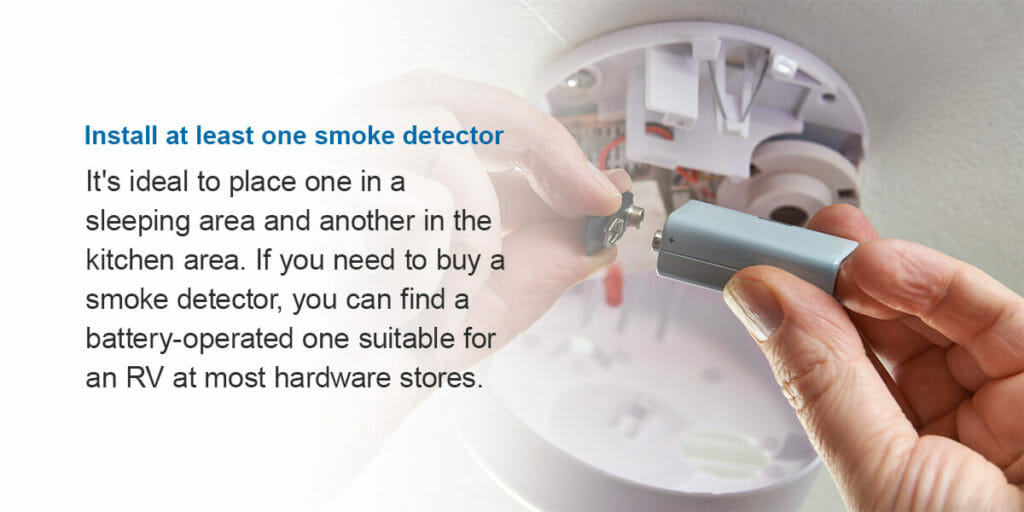
According to RV safety statistics, RVs are more vulnerable to fire than an average passenger vehicle. It's important to stock preventative fire equipment alongside your standard RV safety features. Make your RV fire-safe by doing the following:
- Install at least one smoke detector: It's ideal to place one in a sleeping area and another in the kitchen area. If you need to buy a smoke detector, you can find a battery-operated one suitable for an RV at most hardware stores.
- Get a fire extinguisher to keep in your RV: While the RV is in storage, keep the fire extinguisher inside a permanent dwelling to protect it from extreme temperatures.
- Test your smoke detectors: Familiarize all passengers with the different sounds they might make.
- Have a fire safety plan in place: Be sure everyone knows what to do in case of a fire.
RV Emergency Safety Tips to Consider
Sometimes, you'll experience an unexpected emergency that forces you to react quickly. It's important to know how to act during various emergencies so you and your passengers stay protected. Check out a few emergency safety suggestions to keep yourself and others safe.
Tips for RV Tornado Safety
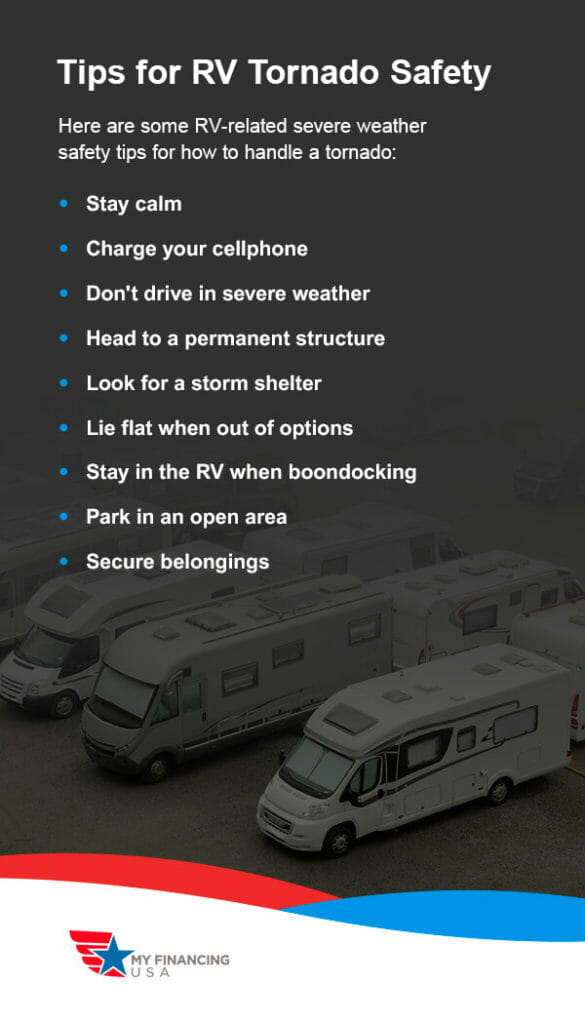
Depending on where you're traveling, you may experience a tornado warning while on the road. Here are some RV-related severe weather safety tips for how to handle a tornado:
- Stay calm: Try to remain calm — the unsafe weather event could pass through the area without causing any problems.
- Charge your cellphone: Check your cell phone to see how much battery life you have left, as you may need to call emergency services.
- Don't drive in severe weather: Never attempt to drive beyond the range of a tornado or thunderstorm. Look for the nearest possible shelter instead.
- Head to a permanent structure: Seek out a permanent building to take shelter in. Avoid taking shelter in an RV or motorhome during a tornado.
- Look for a storm shelter: If you're in an RV park, you may have access to a storm shelter. Call the park's management to find out more information.
- Lie flat when out of options: Wait out the storm in a ravine or ditch while lying flat and covering your head. This action might leave you vulnerable to other environmental hazards, such as hypothermia, but it's recommended by the CDC for reducing your risks.
- Stay in the RV when boondocking: If you're boondocking in a remote area without shelter options, stay inside your vehicle and wait, keeping away from the windows. Wrap yourself in a blanket or towel to protect your body from breaking glass. If you have a helmet, be sure to use it to cover your head.
- Park in an open area: If your only option is to stay inside the RV, make sure you are parked away from power lines, trees, bridges or overpasses.
- Secure belongings: If you plan to stay in your RV during severe weather, making use of RV TV safety straps and other gear to secure your belongings is key for your safety.
Tips for Clearing a Rut
If you get stuck in your RV, follow these RV safety steps for getting free:
- When you know you're stuck, move your foot from the gas and brake gently. If you brake hard, you could jam your brakes, which will make it even more difficult to clear the rut.
- If you can, straighten your steering wheel.
- Move your steering wheel to the left so you can slowly attempt to steer out of the rut. Avoid jerking the wheel back and forth as you attempt to accelerate.
Tips for RV Towing Safety
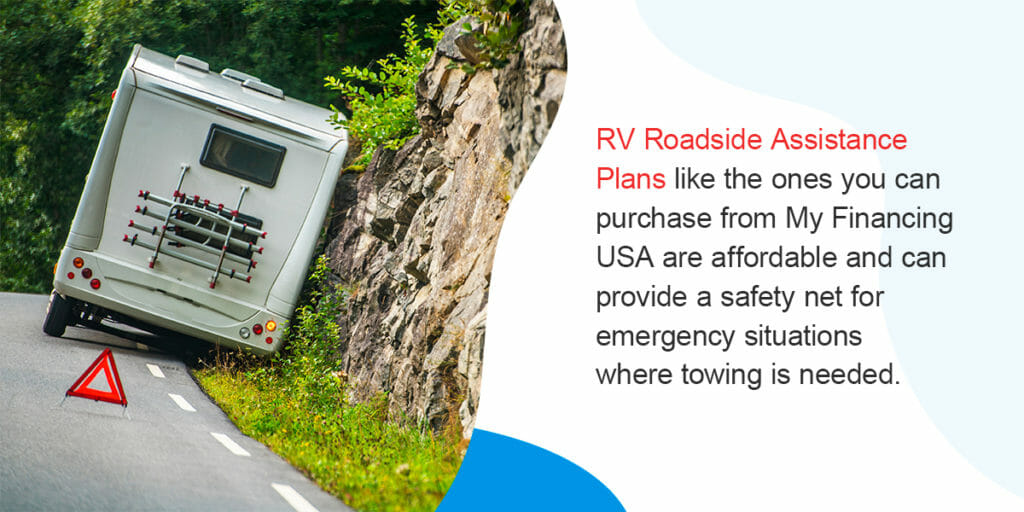
RV Roadside Assistance Plans like the ones you can purchase from My Financing USA are affordable and can provide a safety net for emergency situations where towing is needed. Even if you plan to make short, infrequent trips in your RV, having a reliable roadside assistance policy is crucial. Be able to answer the following questions about your plan so you know how it works:
- How far will roadside assistance tow your RV if you experience mechanical failure?
- Does your policy cover towing a passenger vehicle you're traveling with?
- What does your insurance policy cover that roadside assistance is unable to help with?
5 RV Camping Safety Tips to Help You Stay Protected
Keep in mind that safety is important on and off the road, and you may encounter issues even when your RV isn't in operation.
1. RV Bunk Bed Safety
Here are a few RV bunk safety guidelines:
- Seeing in the dark: Make sure everyone sleeping in the loft or top bunk has a flashlight. This way, they can see how to get down when they have to use the restroom.
- Sleepwalking safety: If you or one of your passengers has a tendency to sleepwalk, you or they should sleep on the lower bunk to reduce the chance of injury.
- Fall protection: Unfold a futon on the floor by the top bunk in a position to cushion the impact of a potential fall.
2. RV Bear Safety
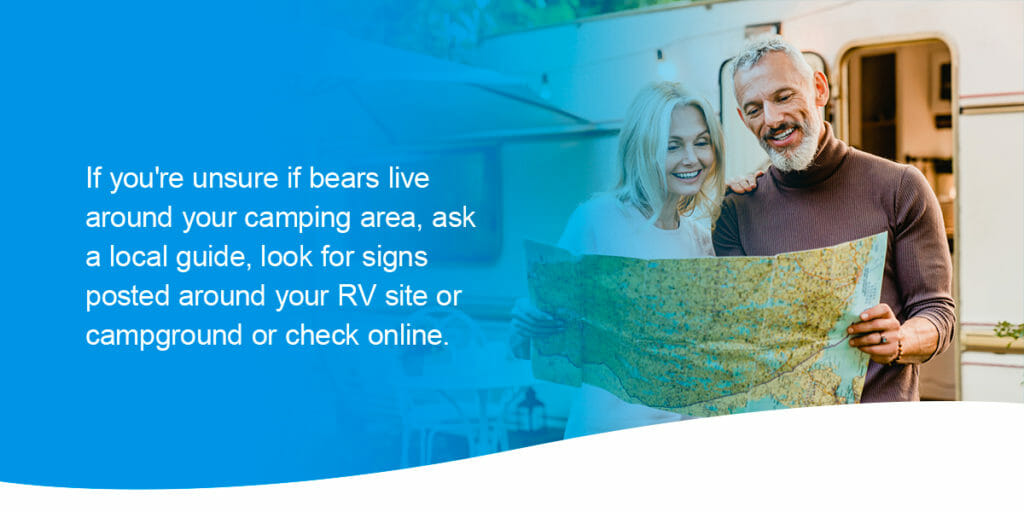
Depending on your road trip plans, you may find yourself in bear country. While bear attacks are extremely rare events, you should still keep a few tips on how to avoid attracting bears in mind. You should also know how to act should you encounter a bear on your journey:
- Do research: If you're unsure if bears live around your camping area, ask a local guide, look for signs posted around your RV site or campground or check online.
- Remove all trash: When camping in areas where bears could be present, avoid leaving leftover food or trash out near your RV. Even if you're unable to detect the smell, a bear could be drawn to it. If you lack access to a trash bin, tie your leftover food up in a tree branch as a distraction to any bears that may wander through your campsite. This way, they'll target the bag of food instead of your RV.
- Bring bear protection: Carry bear spray or a wildlife whistle as a precaution when you're in an area where wild animals could approach you.
3. RV Desert and Forest Wildlife Safety
Other potentially dangerous animals you could encounter include snakes and scorpions. To protect yourself from desert and forest wildlife:
- Check the rules of your park or campground: Warnings about dangerous wildlife are often posted for campers. Even though you're staying in an RV, you're still vulnerable, so you should understand your campground's rules.
- Educate yourself: Always research your campground and the surrounding areas for wildlife risks.
4. RV Pet Safety
Are you planning to bring your furry companions on your trip? Here are some tips for having the best time with your pets:
- Don't stow your pets in the back: Always ride with your animals in your vicinity while driving the RV, even if you have a travel trailer. This trick can keep them calm during long journeys.
- Use a comfortable crate: If your animals are unaccustomed to traveling, it's best to let them stay in a kennel while the vehicle is moving. It's likely they'll feel more secure when confined, and they'll be unable to damage your RV.
5. RV Electrical Safety
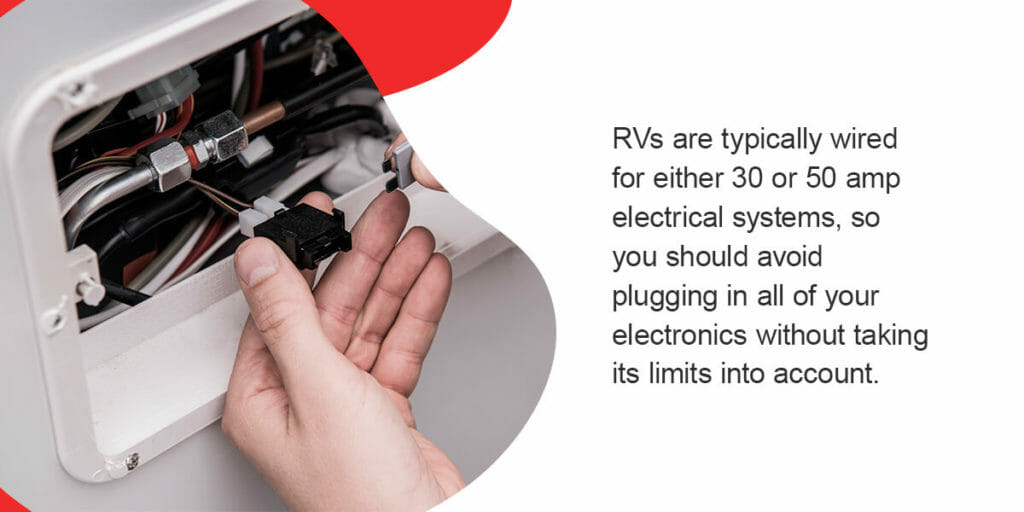
RVs are typically wired for either 30 or 50 amp electrical systems, so you should avoid plugging in all of your electronics without taking its limits into account. Run each appliance as needed while making sure you know how many amps you're using. If an appliance lists watts instead of amps, divide the number of watts by volts to convert the number.
Apply for an RV Loan With My Financing USA
With our top safety tips in mind, you can prepare yourself for the adventure of a lifetime.
Are you ready to start living the RV life? My Financing USA can help match you with a compatible lender for the RV of your dreams, regardless of your credit score. Learn more about our RV loans or apply for an RV loan today!


